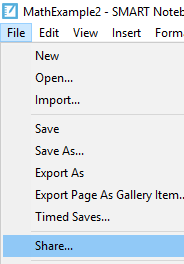

- SMART NOTEBOOK 11 TUTORIAL INSTALL
- SMART NOTEBOOK 11 TUTORIAL FULL
- SMART NOTEBOOK 11 TUTORIAL SERIES
- SMART NOTEBOOK 11 TUTORIAL WINDOWS
The AMD Ryzen 5900X has 12 CPU cores, and it is one of the top CPUs from AMD for gaming. To know how big a difference a GPU makes when training a machine learning model, I am going to do a small competition between my AMD Ryzen 5900X CPU and my Nvidia RTX 3070 GPU. Now that I have Tensorflow installed, we need to test it.

SMART NOTEBOOK 11 TUTORIAL INSTALL
$ conda install matplotlib $ conda install pandas Testing Tensorflow model training with an AMD Ryzen 5900X CPU Let’s install some additional libraries from conda-forge, which are not required by Tensorflow but, are required by the python notebook with which we will later validate that Tensorflow and Keras are fully working. We open a command prompt: $ conda activate tensorflow25 Since we really need CUDA 11.2 support our only option here is pip. So ignore the comments about it being a release candidate Important Update: Tensorflow 2.5.0 was officially released. Furthermore, CUDA 11.2 support seems to be only supported in Tensorflow 2.5.0 which is still a release candidate. The problem with relying on Anaconda to install Tensorflow is that is always a bit behind in versions. Because Tensorflow 2.5 is not yet available in conda-forge and that is the only version that has CUDA 11.2 support, we will skip that for now. Ideally, we should use conda to install Tensorflow and even CUDA. Creating a new Anaconda environment Installing Tensorflow with conda So let’s contain this hell in an environment. Some who have experienced it might describe it as Tensorflow dependency hell. Tensorflow is infamous because of being very sensitive to library dependencies. In this Anaconda environment, we will be able to install TensorFlow and any related dependencies.

Let’s now start Anaconda and create an Anaconda environment for Tensorflow. Creating an Anaconda environment for Tensorflow If you don’t have Anaconda installed, you can follow one of my videos to complete the Anaconda setup. What are we waiting for? Let’s get started! Install Anacondaįor this setup, I am going to be using Anaconda.
SMART NOTEBOOK 11 TUTORIAL FULL
This might be because of tensorflow itself not taking full advantage yet of the Ampere architecture. One of the reasons I am not sure is that there is an open issue in Github regarding the the RTX3090 being slower than the Nvidia RTX1080i for predictions with Resnet. GPUs are much faster than CPUs when handling lots of matrix calculations. Can it beat the AMD Ryzen 5900X CPU? It definitely should. Once I complete the CUDA setup, I will try again to complete the training of the same model with my Nvidia RTX 3070 GPU. The AMD Ryzen 5900X CPU has 12 cores and 24 threads, and it is a decent CPU all around, perfect for a beginner in Deep Learning like myself. I will be training an image classification model that I developed in a previous video, with my AMD Ryzen 5900X CPU.
SMART NOTEBOOK 11 TUTORIAL SERIES
Since CUDA is backward compatible it should also work for RTX 20 series cards or older.īut before I install CUDA, I will do some benchmarking of Tensorflow 2.5 without a GPU.
SMART NOTEBOOK 11 TUTORIAL WINDOWS
In this article, I am going to show you how you can install Tensorflow 2.5, CUDA 11.2.1, and CuDNN 8.1, for Windows 10, with full support for an Nvidia GPU RTX 30 series card.


 0 kommentar(er)
0 kommentar(er)
